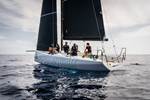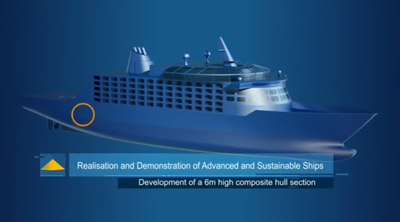FIBRE4YARDS incorporates next-gen composites technologies to redefine shipbuilding
At the project’s completion, consortium members have unveiled final results and a 1:1 scale demonstrator, highlighting the opportunities for more collaborative, digitized, automated, efficient and environmentally friendly shipyards.

1:1 catamaran demonstrator produced using FIBR4YARDS’ Industry 4.0 solution. Photo Credit: IRT Jules Verne
FIBRE4YARDS is a project funded under the European Union’s Research and Innovation Programme Horizon 2020 that is dedicated to the use of fiber-reinforced polymers (FRP) in shipbuilding using Industry 4.0 concepts. Project partner IRT Jules Verne (Bouguenais, France) has announced results after 3 years of collaborative development with 12 other organizations from six European countries.
Traditionally used in the construction of lightweight structures for vessels up to 25 meters, FRPs are now making their way onto larger boats, reaching up to 50 meters. However, the full production potential of FRP vessels remains untapped due to prohibitively high production costs. FIBER4YARDS has addressed this challenge by introducing innovative automated procedures and eliminating semi-artisanal methods, reportedly ushering in a new era for the competitiveness of the sector.
From its start in January 2021, FIBER4YARDS’ goals were to:
- Introduce smart and secure engineering, manufacturing and data sharing concepts in ship production;
- Embed advanced and highly automated FRP production technologies in the Shipyard 4.0 while applying these technologies in ship production, maintenance and dismantling;
- Develop and validate new digitalized engineering and analysis simulation solutions to support modular ship design and construction in the Shipyard 4.0 concept;
- Facilitate industrial deployment of the FRP Shipyard 4.0 by providing guidelines for design, production, certification and staff training; and
- Develop business plans and intellectual property rights (IPR) strategies for shipyards.
The project consortium reports that FRP Shipyard 4.0 is based on three pillars: New technologies for automated construction, a digitalized shipyard and its digital twin and new engineering tools for ship design that take new production technologies into account. Its automated technologies can be used by shipyards or by shipyard suppliers to produce components in the assembly for the shipyard.
The new manufacturing technologies presented to the industry by FIBRE4YARD include:
- Out-of-die UV-cured pultrusion, which enables the automated production of high-performance straight and curved profiles. With this solution, shipyards can directly bond stiffeners to desired areas (e.g., hull, deck, superstructure), eliminating manual lamination and polyurethane molds
- Robotic-based systems for additive manufacturing (3D printing and AFP): Recycled polymers can be 3D printed to develop a rough initial shape, followed by CNC machining to finish it to net shape and improve its surface finish, and AFP to reinforce the prints with unidirectional (UD) tapes.
- Hot stamping of thermoplastic composites for tailored, lightweight structures with optimized strength-to-weight ratios, and ideal for small to medium parts.
- Adaptable molds to create curved structures. This technology enables prefabricated panels in the correct geometry, shape and joint design that can then be assembled into a complete structure using simple jigs. The goal here to eliminate the need for multiple expensive tools.
All data from these technologies is digitally connected and integrated into an open source digital twin of the shipyard using IoT protocols, called OS14.IOT. Detailed monitoring strategies have been defined for all technologies developed under this project to enable real-time identification of key parameters, enhancing quality control, process efficiency and environmental impact.
“In FIBRE4YARDS, we have proven that it’s possible to rethink the shipyard,” says Xavier Martinez, a researcher at CIMNE, one of the project coordinators. “If we digitize it, if we move from manual construction to automated processes, if we incorporate modular construction and, last but not least, if we incorporate and use numerical tools that can take all these processes into account, then we’ll be able to build ships that are cheaper, that have higher quality and with an environmental impact that is reduced through its lifecycle.”
The project’s closure took place in Nantes, France, hosted by Naval Group and IRT Jules Verne, which housed the 1:1 scale demonstrator of a catamaran structure.
To learn more about the features of OS14.IOT, or the results of the project, view the video below:
Related Content
Composites supply chain and production disruptions – how can AI and digitalization help?
Digitizing and creating the factory of the future is a journey, but it has the potential to help composites manufacturers address real-life disruptions and enable fast replanning of production operations for increased flexibility and enterprise-level performance.
Read MoreThermoplastic composites welding: Process control, certification, crack arresters and surface prep
More widespread use of welded composite structures within a decade? Yes, but further developments are needed.
Read MoreBroetje-Automation works with Boeing Germany, consortium in “Shimless Assembly” project
Foundation for future aircraft programs aims for -75% manufacturing time, -25% cost via end-to-end digitization, tolerance compensation and force-controlled joining.
Read MorePlant tour: Sekisui Aerospace, Orange City, Iowa, Renton and Sumner, Wash., U.S.
Veteran composites sites use kaizen and innovation culture to expand thermoplastic serial production, 4.0 digitization and new technology for diversified new markets.
Read MoreRead Next
NLcomp spins off Eco Yachts brand for sustainable composite boat development
Eco Yachts is an Italy-based shipyard that will produce climate-neutral yachts and motorboats with third-party verification using rComposite fiberglass.
Read MoreImpact tests on RAMSSES ship hull demonstrator show resilience of composites
Damen Shipbuilding and project consortium partners test 6-meter-high, resin-infused composite hull section.
Read MoreAl Seer Marine, Abu Dhabi Maritime unveil world’s largest 3D-printed boat
Holding the new Guinness World Record at 11.98 meters, the 3D-printed composite water taxi used a CEAD Flexbot to print two hulls in less than 12 days.
Read More










.jpg;maxWidth=300;quality=90)















